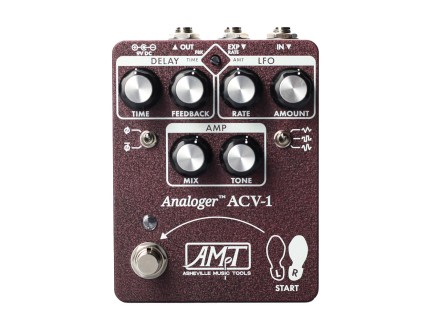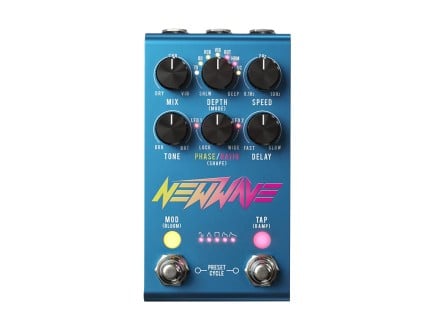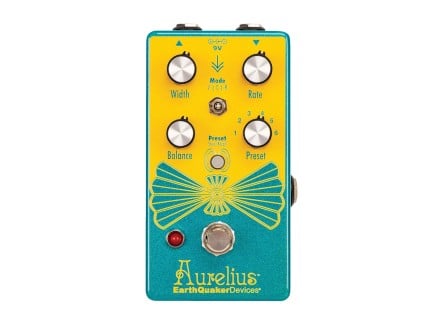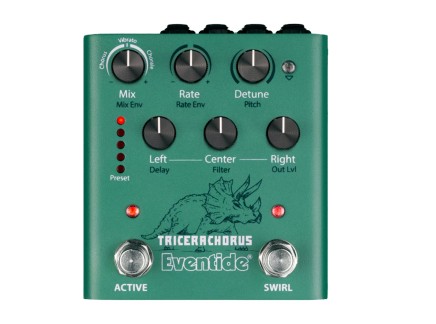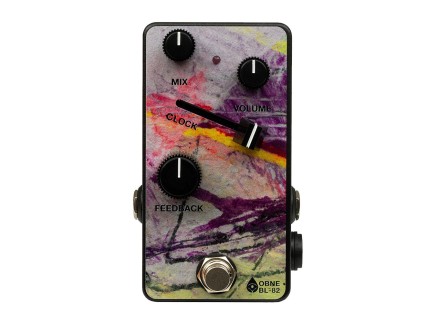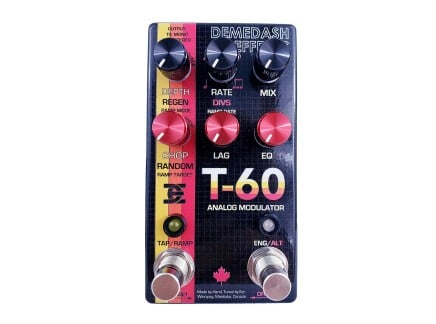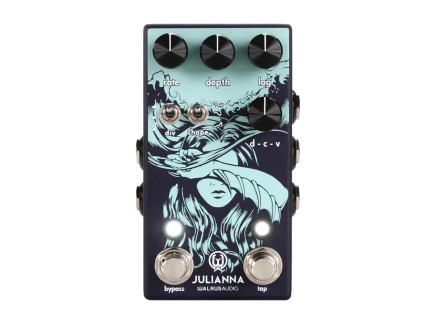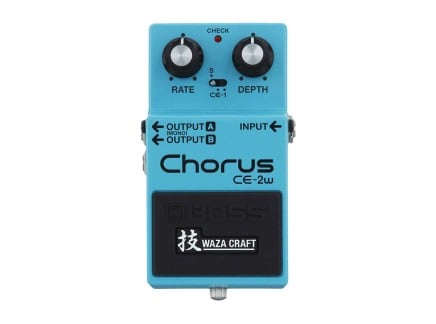At its simplest, when you have multiple instruments with the same timbre playing the same note together, you get a chorus effect. Why? Typically, even when instruments are playing the same note, there are slight variations in the pitch and timing of the individual instruments. This slight variation is perceived as a bigger, wider sound—it seems unified, but more complex than could be produced by a single instrument alone. This is what you hear in an orchestra with multiple violinists or cello players. This concept forms the basis of the chorus effect in audio production.
The electronic chorus effect is achieved in a conceptually similar way. A copy (or multiple copies) of an audio signal are mixed with the original. Slight modulation is added to the pitch of the duplicate signal(s). The pitch modulation is achieved by adding a delay time to the duplicate signal. The delay time itself is modulated with a low frequency oscillator (LFO), which results in subtle pitch variations. This is similar to how vibrato effects are commonly achieved in analog hardware—however, with chorus, the modulated signal is mixed together with the dry signal, creating a swarming, detuned effect that mimics the sound of those natural pitch deviations in instrument ensembles.
But, where did this idea originate, and how has it evolved across the ages? Let's dive in.
Origins of Chorus: Hammond Organs
The earliest examples of the chorus effect can be heard on Hammond tonewheel organs, particularly the BC model that was introduced in the 1930s. The BC model had a built-in chorus effect (hence the C in the name). Hammond introduced the chorus effect to address the criticism of the organ sounding flat when compared to pipe organs. (Note: their quest to add a touch of depth to their organ sounds also led Hammond to embrace spring reverb, a concept originally developed by Bell Labs...but that's a story for another day.)
Hammond tonewheel organs of the 1930s and '40s achieved the chorus effect by using the principle of electromagnetism. Steel tonewheels are placed close to a bar magnet about the size of a pencil. One end of the magnet has a sharp edge. This end is close to the tonewheel, which has jagged teeth. In addition, this edge of the magnet has a coil of wire wound on it. As the tonewheel rotates and the teeth pass very close to the magnet, it induces a change in the magnetic field, which, in turn, produces a voltage in the wire. The value of the voltage is determined by the speed at which the jagged teeth pass close to the magnet. For example, if the tonewheel is rotating at a speed such that two hundred and twenty teeth pass close to the sharp edge of the magnet, we get a voltage which fluctuates at a frequency of 220 Hertz. 220Hz is the A note on your piano.
Two or more such tonewheels were stacked, each with a slightly different number of jagged teeth. For example, you had one tonewheel with X number of teeth, a second tonewheel with X - 1 number of teeth, a third tonewheel with X + 1 number of teeth (and so on). Each of the tonewheels produced a frequency very close to each other, resulting in the chorus effect.
The 1960s: the Beatles and Automatic Double Tracking
In the '40s and '50s, studios started experimenting with magnetic tape for recordings. It is during this time that engineers discovered tape delay as an audio production technique. Experimentation with tape manipulation was common in this period—it was the original source of the flanger effect, for instance, among many other clever audio manipulation techniques.
Automatic Double Tracking (ADT) is one such technique—one that became a sought-after method for thickening up vocals and guitars. Prior to ADT, it was a somewhat common practice to double-track instruments or vocals—recording the same musical line in two separate takes—in order to add an ensemble-like characteristic. ADT emulated this sound in a, well, automatic way, hence the name.
In ADT, a copy of an audio signal was played on the top of the original after a slight delay. This slight delay between the two signals led to phase-shifting, giving the final output a chorus-like quality. The ADT technique was, primarily, made famous by the Beatles in the '60s when they were recording at Abbey Road Studios with Sir George Martin (who was responsible for many of the Beatles' more peculiar and creative recording tricks).
[Above: the Roland RE-301 Chorus Echo. Images from Perfect Circuit's archives.]
The continued use of magnetic tape for creative effects like delay and ADT led to the advent of tape delay—and ultimately, the development of devices like Roland's iconic Space Echo series. In 1977, Roland released RE-301, which had a dedicated built-in chorus effect. You could use the chorus effect independently or simultaneously with the tape delay.
The 1970s: Roland Jazz Chorus Amps and the Chorus Revolution
In 1975, Roland released their first Jazz Chorus (JC) amps. This was a seminal moment in the history of audio production. One, JC amps used solid-state circuitry, which was a move away from the norm at the time. Up until then, manufacturers relied on tube amps, which were relatively high-maintenance. The solid-state circuitry of the amps allowed Roland to achieve a clean sound with plenty of headroom. This was in stark contrast to the saturated tones of the tube amps.
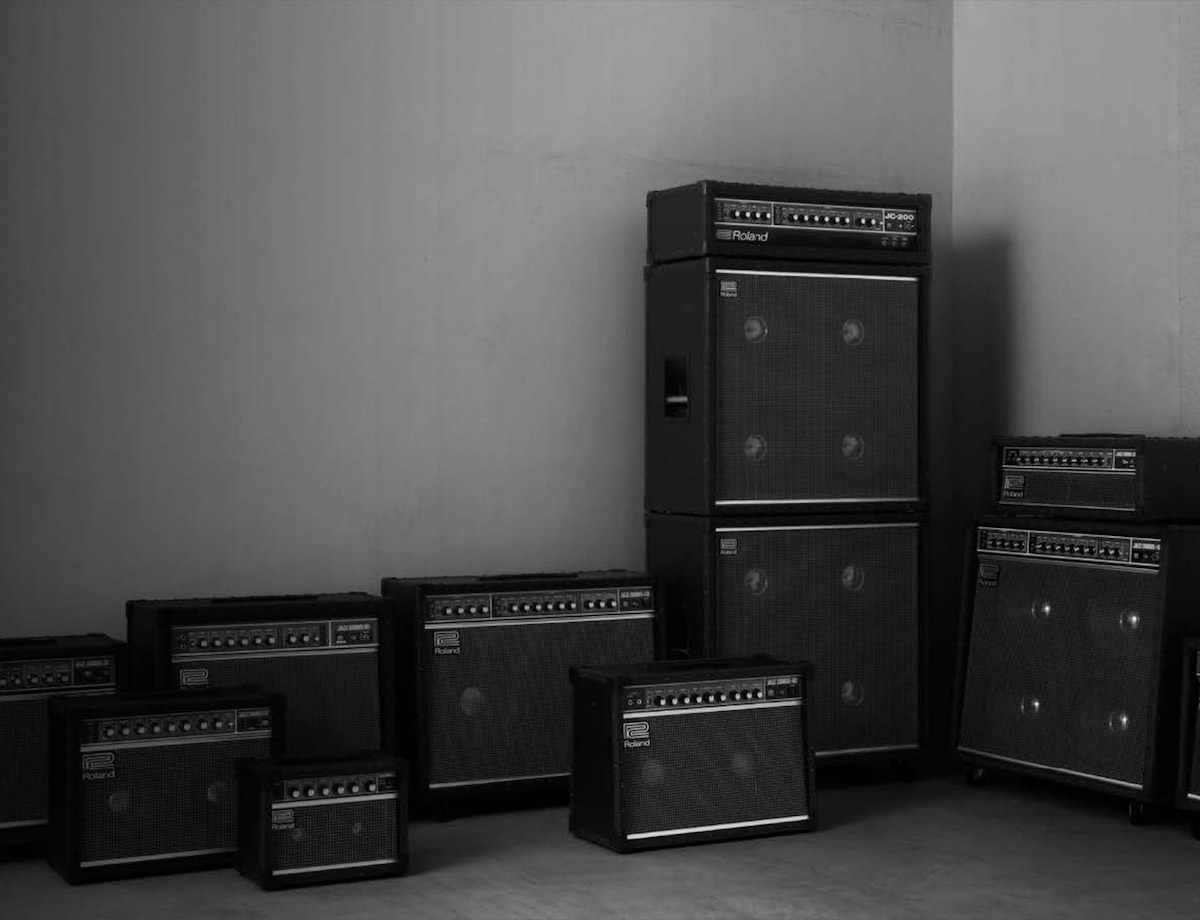
[Above: an assortment of Roland Jazz Chorus amplifiers. Image via Roland's website.]
The Jazz Chorus amps were also the first to have built-in chorus and vibrato effects. The amps had two independent 60-Watt amplifiers that each powered independent 12-inch speakers. Since there were two amplifiers, you had two channels of audio, which could be manipulated independently. To achieve the chorus effect, one channel’s signal was slightly delayed, and its pitch cyclically modulated. The slight pitch-shift between the two channels resulted in the chorus effect.
Roland JC amps used the iconic MN3002 Bucket Brigade Delay (BBD) chip for achieving the chorus effect. Guitarists during the time immediately took to the lush, warm tone of the JC amps' chorus. Popular guitarists such as Andy Summers (Police), Steve Hackett (Genesis), and Wes Borland (Limp Bizkit) exemplified the sound of Jazz Chorus amps. Roland had a hit on its hands...and Jazz Chorus amps remain some of the best-loved solid-state amps to the current day.
Boss CE-1 and CE-2
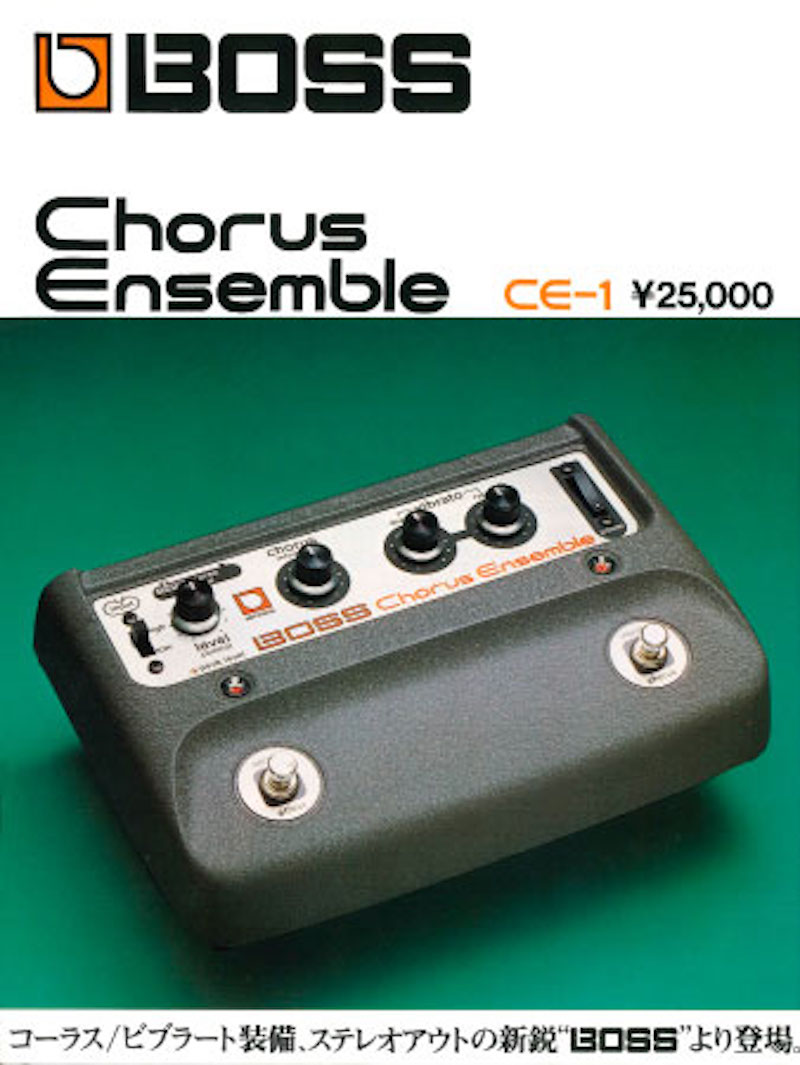 Vintage ad for the original CE-1 chorus pedal
Vintage ad for the original CE-1 chorus pedal
Such was the success of the chorus effect in Jazz Chorus amps that only a year later, Roland released a standalone chorus pedal: the Boss CE-1. The first-ever chorus pedal, Boss CE-1 used the same circuitry as the Jazz Chorus amps. The incoming audio signal was split into two—a dry signal that went straight to the output, and a wet signal that went through a modulated delay circuit.
Much like in the Jazz Chorus amps, this delay circuit used a BBD chip. The BBD chip was clocked with an external clock. The clock, in turn, was modulated with an LFO, which resulted in cyclic pitch changes. This modulated signal then went through a filtering stage before being mixed with the dry signal. Like the JC amps, Boss CE-1 had both vibrato and chorus effects.
A few years later, Roland released CE-2. It was a lot more compact than CE-1, and used a similar circuitry as that of CE-1. Today, the CE-2 is, again, a sought-after tool; for many, it defined the sound of 1980s guitar.
The 1980s and Juno-6
In the early part of the 1980s, Roland also released their Juno series synthesizers, starting with the Juno-6. It was one of the first affordable (relatively speaking) polyphonic synthesizers at the time, and was a tremendous hit. The synthesizer offered 6-voice polyphony and a resonant filter section for shaping your sound.
But Juno-6 also became popular for its chorus effect—an integral part of its overall sound. The chorus on Juno-6 worked by sending an audio signal to two delay lines, which were panned left and right. An LFO modulated the delay lines, resulting in pitch changes. This modulated signal was mixed with the dry signal to achieve the chorus effect. The chorus on Juno-6 quickly became a favorite among musicians at the time for its distinct sonic quality. Slightly noisy, it allowed a wide palette of swirly textures, which became one of the defining sounds of the '80s. Interestingly, the chorus on Juno synthesizers had no variable controls: simply buttons for choosing between a couple of distinct chorus flavors.
[Above: detail of the right-hand side of the Roland Juno-6, Juno-60, and Juno-106 synthesizers—including their Chorus section controls. Images via Perfect Circuit's archives.]
In subsequent years, Roland released iterations of Juno-6 with improvements and added features. Notably, there was Juno-60, the successor to Juno-6, that could store patches internally. And finally, Juno-106, which had larger internal memory and MIDI capability. The chorus effect on these iterations remained the same, with only minor adjustments to the sonic character.
Roland and Boss would continue to produce some of the most interesting and well-loved chorus effects for decades to come, in both analog and digital formats.
The 1990s and Electro-Harmonix Small Clone Revival
Towards the end of the '70s, another company was manufacturing chorus pedals—Electro Harmonix. The company came out with its Small Clone chorus pedal in 1979. However, it wasn’t until the '90s that the pedal gained mainstream recognition, thanks to Kurt Cobain. The iconic Nirvana guitarist used the chorus pedal on countless records, including one of the band’s most famous numbers, "Come As You Are."
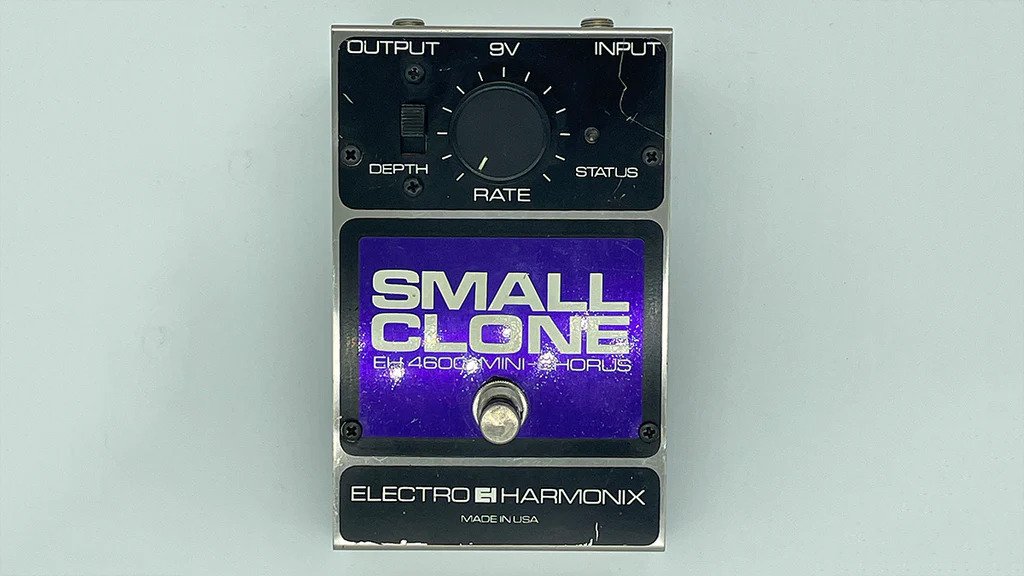
[Above: a vintage Electro-Harmonix small clone. Image via pedal maker Catalinbread's website, in their dedicated article about the history and functionality of the Small Clone.]
The original design of Small Clone used either the ubiquitous MN3007 BBD chips, or the less popular SAD 1024 chips (interestingly, the SAD chips are heavily sought-after in the current day and age). The lush, shimmery sound of the pedal became so popular in the '90s that EHX came out with a reissue in the early 2000s. The Small Clone reissues use the same MN3007 BBD chips—however, the original circuitry has been tweaked slightly to adjust the sonic quality compared to the original.
A Few of Our Favorite Modern-Day Chorus Pedals
A lot of the iconic chorus pedals from the '70s and '80s paved the way for modern-day chorus stompboxes. For example, typically, there is no feedback path in classic chorus circuitry. Some modern-day chorus pedals, on the other hand, use BBD chips in conjunction with feedback circuitry. The feedback path allows a wider range of sonic capabilities, allowing musicians to go in unchartered territories.
We have rounded up some of the most interesting chorus pedals out there that are inspired from the technology that came before them.
Asheville Music Tools ACV-1
The Asheville ACV-1 is an all-analog chorus pedal. It uses the classic MN3007 BBD chip to achieve the chorus effect.
It was designed by one of the lead engineers on Moog's original Moogerfooger pedal line—and in turn, as you might expect, it has a number of not-so-common tricks up its sleeve. For example, you can continuously vary the delay time, something that is not very typical in chorus pedals. With a medium delay time, you get a more '70s style chorus sound. Increase the delay time to get a more drippy chorus sound, reminiscent of the '80s. Shorter delay times result in flanging tones.
The ACV-1 also has a feedback knob, which is (again) atypical of chorus pedals. With feedback settings, you can explore more experimental tone-shaping options. For example, high feedback values give you more resonant tones. You can shape the tone of the feedback circuit itself with the ‘Tone’ knob. Note that ACV-1 is a mono-in, mono-out pedal, with no direct support for stereo processing.
Jackson Audio New Wave
Much like ACV-1, New Wave by Jackson Audio uses analog BBD circuitry and MN3007 chips. In addition, it has a digital microprocessor, which lets you store presets and dial-in your settings with much more precision.
The top panel of the chorus pedal has a ton of controls to shape the tone of your chorus effect. You can switch between 7 different presets, from the vintage tone of the '70s to user-defined settings.
There are two LFOs (one for each side of the stereo image), and five different LFO shapes to choose from—as well as the ability to establish specific phase and/or rate ratio relationships for the modulation on each side of the stereo image. New Wave also comes with tap tempo and MIDI functionality, which allows you to control it with other instruments, such as your synthesizer or other external MIDI control sources. New Wave offers the option for stereo I/O on TRS connectors, great for synths or anything else you throw at it.
It's a new take on chorus—with the same deep analog tones you'd expect, under exacting digital control. That's the type of combination that gets us quite excited.
EarthQuaker Devices Aurelius
Inspired by the aforementioned Boss CE-1, the EarthQuaker Devices Aurelius is a digital chorus pedal. You can switch between three modes—chorus, vibrato, and rotary. There are 6 programmable presets you can play around with—dialing in specific sounds for different songs, or for changing chorus tones on-the-fly. The expression pedal input gives you hands-free control over the depth and width parameters, great for exploring the effect's expressive potential.
Despite the (seemingly) limited number of controls on the panel, the pedal offers a substantial array of sonic possibilities. Note that Aurelius is a mono-in, mono-out pedal with no direct support for stereo processing.
Eventide TriceraChorus
The TriceraChorus by Eventide is a digital chorus pedal with three chorus voices that can be tweaked independently.
The pedal takes inspiration from BBD-style chorusing. It also features Eventide’s signature MicroPitch detuning. Coupled with the BBD-style chorus, it results in a lush chorus effect. You can choose between three different chorus effects. And there is a handy ‘swirl’ switch for getting into psychedelic flanging tones and phasing effects.
Again, TriceraChorus offers preset memory, as well as stereo I/O—and supports MIDI via USB. This makes it one of the most sophisticated options on this list, great for deep exploration of chorus's unique potential as a performative sound design tool.
Blood Noise Endeavors BL-82 Chorus
The BL-82 Chorus pedal by OBNE takes an experimental approach to chorusing. The pedal uses two delay lines that are modulated with LFOs—but the heart of the pedal is the sliding clock rate, which can go from extremely fast to really slow. This macro control affects the performance of all other parameters, allowing for significant single-slider control of the effect's overall rate and audio quality in general. The clock goes slow enough that what might start as a shimmery chorus can evolve into a grimy delay: it's all about exploring the boundaries between these distinct-yet-related types of audio effects.
The pedal is capable of shimmering choruses, flanging tones, noisy textures, and territories in between. Like a lot of modern-day chorus pedals, the BL-82 has a feedback knob that gives you more sonic capabilities. As with some of the others we've mentioned, it offers only mono input and output, with no direct stereo support.
How to Pick the Right Chorus Pedal
Consider the tone as the foremost guiding factor when shopping for chorus pedals. Are you after a vintage tone reminiscent of the '70s and '80s? Maybe a reissue of EHX Small Clone or Boss CE-2 is what you are looking for. Do you want a "cleaner" chorus tone? Something like an EQD Aurelius might be more suitable for you, in that case.
In addition to tone, also consider how much control you want over shaping the tone. For example, something like an Asheville ACV-1 gives you a lot of options for shaping the tone of your choruses. An Aurelius, on the other hand, has fewer options.
There is also the factor of analog imperfections to take into account. Digital circuitry allows you to dial-in precise settings. Analog circuitry, on the other hand, can be "moody." If you don't want to live with the idiosyncrasies of the latter, pick a digital chorus pedal. Idiosyncrasies of the analog world can be beautiful, though. They can lead you down unexpected sonic roads, which can unlock newer creative ideas.
Be sure to check out our full selection of chorus pedals; and if seeing all the options out there overwhelms you, we have got your back. Feel free to reach out if you have any questions!








